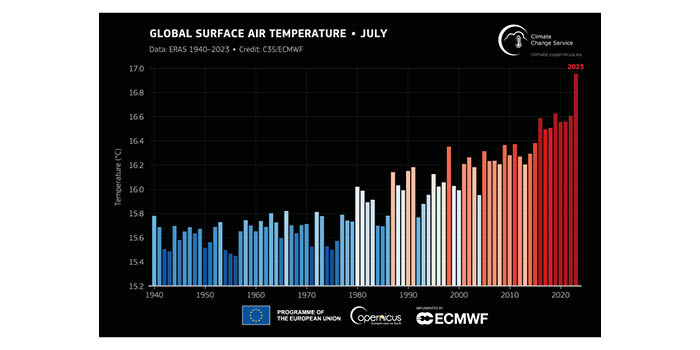The Copernicus Climate Change Service (C3S) has published its July climate bulletin reporting on the changes observed in global surface air temperature, sea ice cover and hydrological variables. All findings are based on computer-generated analyses using billions of measurements from satellites, ships, aircraft and weather stations around the world.
Surface air temperature highlights:
- The global average temperature for July 2023 is confirmed to be the highest on record for any month.
- The month was 0.72°C warmer than the 1991-2020 average for July and 0.33°C warmer than the previous warmest month, July 2019.
- The month is estimated to have been around 1.5°C warmer than the average for 1850-1900.
- Heatwaves were experienced in multiple regions of the northern hemisphere, including southern Europe.
- Well-above average temperatures occurred over several South American countries and around much of Antarctica.
Sea surface temperature highlights:
- Global average sea surface temperatures continued to rise, following a long period of unusually high temperatures since April 2023, reaching record high levels in July.
- For the month as a whole, global average sea surface temperatures were 0.51°C above the 1991-2020 average.
- The North Atlantic was 1.05°C above average in July, as temperatures in the northeastern part of the basin remained above average, and unusually high temperatures developed in the northwestern Atlantic.
- Marine heatwaves developed south of Greenland and in the Labrador Sea, in the Caribbean basin, and across the Mediterranean Sea.
- El Niño conditions continued to develop over the equatorial eastern Pacific.
Samantha Burgess, deputy director of C3S, said, “We just witnessed global air temperatures and global ocean surface temperatures set new all-time records in July. 2023 is currently the third warmest year to date at 0.43°C above the recent average, with the average global temperature in July at 1.5°C above preindustrial levels.”
From January to July, the global mean for 2023 is the third highest on record, at 0.43°C relative to 1991-2020, compared with 0.49°C for 2016 and 0.48°C for 2020. The gap between 2023 and 2016 is expected to narrow in the coming months, as the latter months of 2016 were relatively cool (reducing the annual average to 0.44°C), while the remainder of 2023 is expected to be relatively warm as the current El Niño event develops.
Sea ice highlights
- Antarctic sea ice extent continued to break records for the time of year, with a monthly value 15% below average, by far the lowest July extent since satellite observations began.
- As in June, the daily Antarctic sea ice extent remained substantially below previously observed values for the time of year throughout the month.
- Sea ice concentrations were most below average in the northern Weddell, eastern Bellingshausen, and northern Ross seas, while above-average concentrations persisted in a broad Amundsen Sea sector.
- Arctic sea ice extent was slightly below average, but well above the record minimum from July 2020.
- While most of the Arctic Ocean saw below-average sea ice concentrations, above-average concentrations prevailed north of the northern Siberian coast.
Hydrological variables highlights:
- July was wetter than average over most of northern Europe and in a region from the Black Sea and Ukraine to northwestern Russia.
- Drier-than-average conditions were experienced across the Mediterranean basin, with Italy and southeastern Europe having the largest anomalies.
- July was wetter than average over northeastern North America, Afghanistan, Pakistan, northeastern China, northern and eastern Australia and Chile.
- Extratropical drier-than-average regions included Mexico and the southwestern USA, central and southeastern Asia, southwestern Australia, and parts of southern Brazil and Paraguay.



